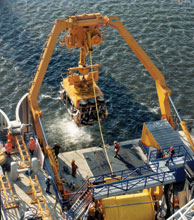...much of the new work so far has been upgrades from 115 kV to the 230 kV levels. There has been some planning for major new lines in the 345-kV to 500-kV range but very little actual contracting. Projects like Path 15 that have strong political backing are exceptions to the rule. I dont think that will change anytime soon, she says.
Oskvig at Black & Veatch agrees, saying the crying need is for new interregional projects that go beyond helping one utility with its reliability problems to serve the national bulk power market. Theres a lot of ideas but not enough action, he says.
Uncertainty has crippled the Empire Connection project, a 130-mile high-voltage direct-current (HVDC) underground line that would provide 2,000 MW of new transmission capacity between Albany and power-short New York City. An auction of capacity on the line in February 2004, which was meant to raise most of the $700-million construction cost was a failure because prospective investors were unsure how they would recover their costs (ENR 3/8 p. 7). And in New England, the 24-mile Cross-Sound cable between Shoreham, N.Y., and New Haven, Conn., was built in 2002 on a merchant basisa first for the U.S.supported by a long-term lease to the Long Island Power Authority. But Connecticuts environmental objections kept the line closed until the DOE used emergency powers to open it after the 2003 blackout. It has remained in operation under the DOE order, which is under court challenge.
 |
| TRANSMISSION AT SEA Cross-Sound cable was first merchant line, but Connecticut objections stymied operations. (Photo courtesy of Transénergie USA) |
Connecticut towns also are challenging a plan by Northeast Utilities and United Illuminating to build a 69-mile, $604-million, 345-kV line from Middletown to Norwalk by 2007 to prevent outages in the generation-short southwestern corner of the state. NU has waged a strong public-relations campaign at a series of town meetings to stress the need for the line. But the state Siting Council, under strong political pressure, just announced it will delay a decision on the issue until the end of the year to give opponents more time to make their case.
Stephen Whitely, senior vice president for the Independent System Operator-New England (ISO-New England), which assures reliability in the area, warns the not-in-my-backyard issue is likely to be a major impediment all over New England, where the ISO has identified over $2 billion in needed projects and utilities are willing to invest based on hefty incentives allowed under new FERC policies.
One ray of hope in this picture has been the Rocky Mountain states, which have realized that building new transmission lines and exporting power from local plants is the best way to exploit their large coal and wind resources.
They have set up a group to identify where the regional grid needs to be expanded and invite private firms in to build lines with the promise that the state governments will expedite siting. Some states, like Wyoming, have formed their own state agency to build lines if the private sector will not (ENR 3/15 p. 11).
Transmission owners have not spent money on technology to convert the old electromechanical system to electronic operations, such as the so called smart grid technology needed to handle increasingly complex configurations and real-time power flows. An August 2003 EPRI report says this new technology is essentially sitting on the shelf. Smart-grid improvements are designed to solve the kinds of problems with system monitoring and control highlighted in the final DOE report on the August blackout issued in April 2004 (ENR 11/24/03 p. 15).
Some utilities already are installing new types of equipment to provide better control over voltage levels. But the more sophisticated applications are still in the testing stages, including a series of demonstrations just announced by the California ISO in partnership with a consortium of DOE research laboratories that will provide real-time data about grid operations in the West and nationwide.
|
Clark Gelling, EPRI vice president for power delivery, estimates that about $110 billion in extra investment will be needed over the next 20 years, or about $5 billion annually above the current baseline of $2.5 billion, to expand the grids capabilities in line with demand and improve reliability to acceptable levels.
Gelling notes that his estimate assumes a heavy dose of investment in smart-grid solutions, which will allow the industry to get more performance out of its existing lines and equipment. Just adding more capacity using traditional technology to solve the same problem could cost $400 billion, he says.
The big question, says R.W. Becks Tripp, is, Where is this money going to come from. The electric industry says it can do the job if the politicians reach agreement on clear policies for the transmission sector that settle jurisdictional and market...
